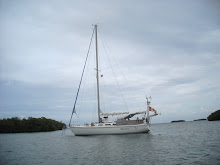 Venezuela is such an incredible country. We are so glad we came!!! So many cruisers are reluctant to come here because of the risk of piracy and crime but our experience has been wonderful! The Venezuelans that we have met are so genuinely friendly and considerate. It’s unfortunate that the BAD guys are out there. But the local people are affected by the crime rate as well, even more than the average cruiser. The country is ripe with natural resources but the inflation rate was reported at 13% in October. We really hope that the government can turn things around. The caring people of Venezuela deserve nothing less.
Venezuela is such an incredible country. We are so glad we came!!! So many cruisers are reluctant to come here because of the risk of piracy and crime but our experience has been wonderful! The Venezuelans that we have met are so genuinely friendly and considerate. It’s unfortunate that the BAD guys are out there. But the local people are affected by the crime rate as well, even more than the average cruiser. The country is ripe with natural resources but the inflation rate was reported at 13% in October. We really hope that the government can turn things around. The caring people of Venezuela deserve nothing less.As far as Sailors go, the cruising is excellent. More islands to explore than time would ever permit. So many uninhabited places & I have never seen so many beaches (except maybe in the Bahamas). If you want to explore inland, there is a vast and almost endless list of places to go and things to do.
Novemeber 28th. We left Caya Herradura, (Tortuga) Wednesday evening under a double reefed main and full genny. Again we had an incredible night sail till about 5 am when the wind died and we started wallowing in the swell. Time to motor the rest of the way to Los Roques. At 9:30 am we passed through the channel in the reef at Boca de Sebastopol. From here we motored north in deep water between the outer reef and the middle reef. The water was very clear and it was easy to see all the shoal areas. Another interesting experience in reef navigation. By 12:15 pm we were anchored off the island of Francisquies along with Gabrielle and Side By Side, the 2 boats we left Los Tortuga with. 99.6 nautical miles covered.

Los Roques is about 75 miles off the coast of Venezuela and covers an area about 14 by 25 miles. It is a series of islands protected by reef-studded water. Every island has a collection of beaches and good snorkeling. The area is also a National Park that attracts a lot of Venezuelan tourists. There is a quaint little town and airport on the main island of Gran Roques.
 The tourists fly in here then the local tour operators take them out to the numerous beaches for sun and snorkeling. Despite the tourists, we were still able to find some secluded anchorages.
The tourists fly in here then the local tour operators take them out to the numerous beaches for sun and snorkeling. Despite the tourists, we were still able to find some secluded anchorages.Wednesday December 5th. It was uncharacteristically calm during our stay. Usually the wind blows 20 knots all the time. Our next stop was to be the Islas de Aves, little island archipelagos that got their name from all the birds that inhabit them. We got restless waiting for the wind to return, so we motored the 32 miles to Isla Sur, Aves de Barlovento (south island, windward island of the birds). On Thursday we motored the next 16 miles to Aves de Sotavento (leeward island of the birds). That night the wind returned along with lots of rain. We delayed our departure in the morning waiting to see what the weather would bring.
Friday December 7th. We had a dead downwind motor/sail from the Aves to Bonaire, a 40 mile trek. The wind died after the first ½ hour so it was pretty uncomfortable with the swell of the following seas. Oh well, we take the bad sails along with the good.
We made our destination and celebrated with an incredible fish dinner at the Mona Lisa Restaurant. Bonaire is wonderful. Will elaborate next posting.
Till next time,
Fair Winds,
Miriam
12°09.3’ N
68°16.8’ W
 Playa El Faro
Playa El Faro




































 One of the numerous caves in La Vache Bay. There were much biggger ones but our camera battery died. Great dinghy exploration though.
One of the numerous caves in La Vache Bay. There were much biggger ones but our camera battery died. Great dinghy exploration though.









